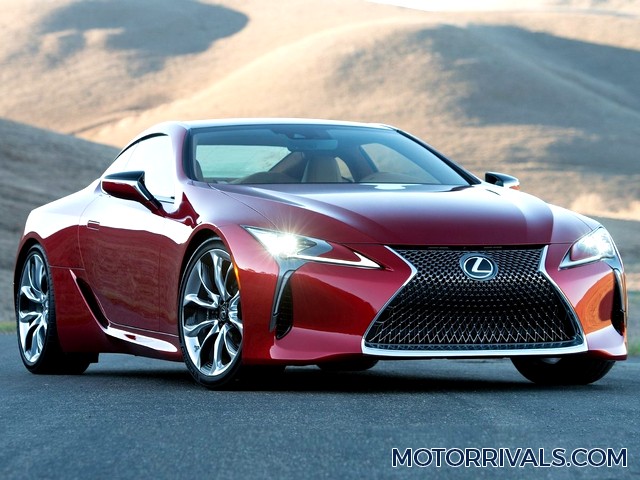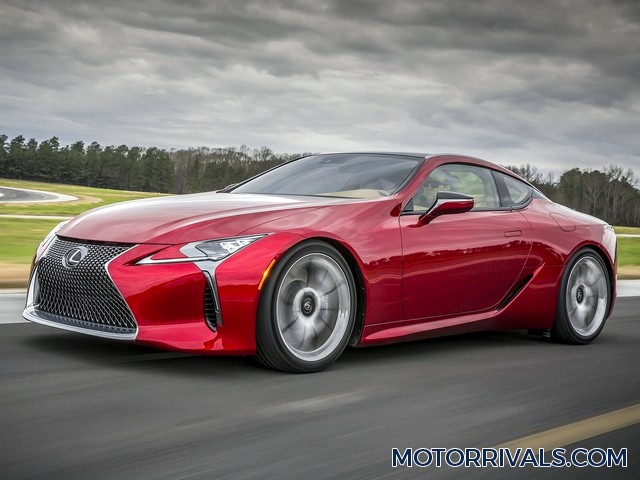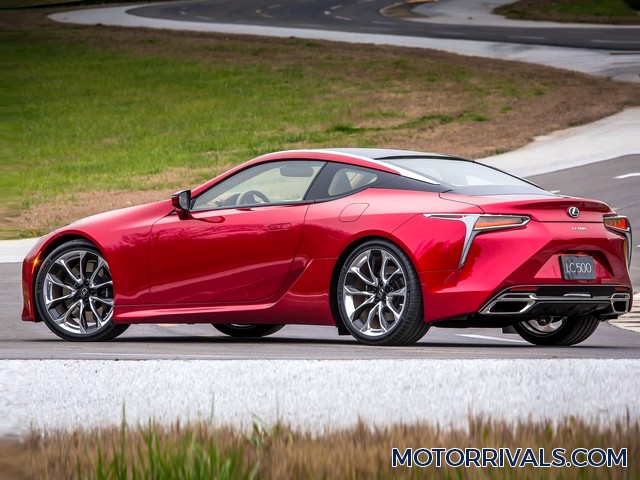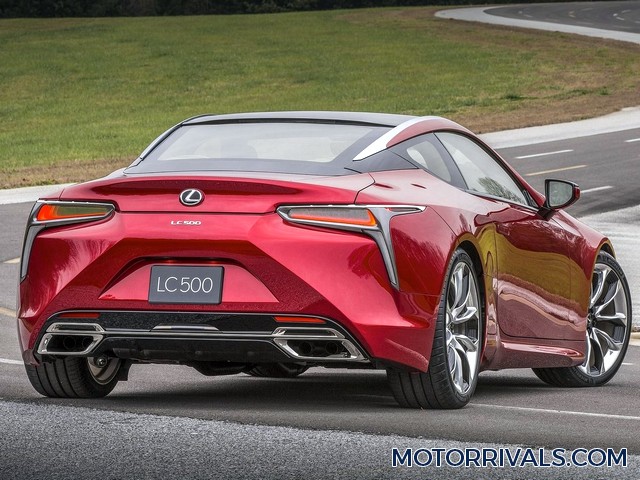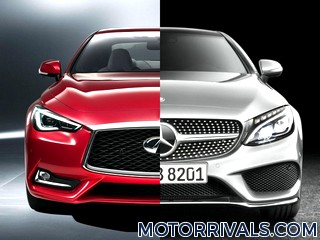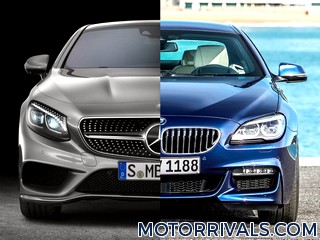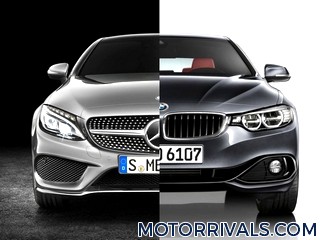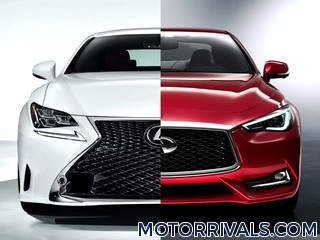2017 Lexus LC 500 vs 2016 Mercedes-Benz S-Class Coupe
Lexus LC 500 Press Release Highlights
Chassis
The LC 500 is the first Lexus to use the brand’s all-new, premium rear-wheel-drive luxury platform and is part of the new corporate global architecture for luxury vehicles (GA-L). The underpinnings of this new coupe will become the blueprint for the company’s future front-engine/rear-wheel-drive vehicles. In an effort to sharpen the car’s handling, the LC 500’s engineers focused on the platform’s fundamentals by placing most of the mass, including the engine and the occupants, in a position more centralized and lower in the chassis to improve the center of gravity.
Other mass management measures include the available carbon fiber roof, aluminum door skins mounted to the carbon fiber door inner structure, and a composite trunk floor. The LC 500 also represents the Lexus brand’s most intensive use of high-strength steel. This provides enhanced rigidity while reducing—and ideally positioning—vehicle mass to optimize dynamics. As a result, the LC 500 is very balanced with a nearly ideal front/rear weight distribution of 52/48.
To help achieve the level of chassis performance targeted for this new coupe, Lexus engineered the stiffest unibody the brand has ever produced. For LC 500, the strategic use of lightweight, high-strength steel helps make for a high degree of torsional rigidity that is more resistant to twisting forces than the exotic, carbon fiber-intensive LFA supercar. The platform design maintains a consistent level of resistance to flexural forces and stiffness across the vehicle’s wheelbase to help create consistent, predictable handling behavior and sharper steering responses. Special braces in the engine compartment (usually a more twist-prone part of the chassis), the adoption of stiff aluminum front suspension towers, and the addition of a ring structure near the rear fenders are all measures that help further bolster the strength of key chassis structures.
Particular attention was devoted to the LC 500’s multilink suspension system. Double ball joints on the upper and lower control arms allow for control of the smallest movements from the driver inputs and road conditions. Beyond sharing workload, a dual ball joint arrangement helps optimize suspension geometry to increase wheel control and create a more precise steering response with better initial effort. To help reduce unsprung mass and improve suspension response, all but one of the control arms are made of lightweight forged aluminum. Providing the grip on the show prototype car are concept versions of Michelin Pilot Sport tires with Premium Touch® sidewall technology: 245/40RF21 up front and 275/35RF21 at the rear. When all the handling elements come together, LC 500 becomes a world-class luxury sports coupe that exhibits razor-sharp reflexes, exceptional handling balance and rock-solid stability. This all-new platform will continue to undergo continuous improvement and enhancement throughout the vehicle’s lifecycle.
Said Sato: “We spent more than triple the usual amount of R&D time to pursue linear steering and to find the sweet spot for road contact feel. We also focused our efforts on suspension rigidity and enhancing geometry. Thanks to advancements in product engineering, we are now at a world-class level for suspension rigidity, and performance when lateral g’s are applied.”
Powertrain
The power delivery to the rear wheels for LC 500 is handled by a new, very well matched set of components that maximize output to the wheels. The heart of the new LC 500 is derived from the proven, high-revving 5.0-liter V8 that is found in the RC F and GS F. The naturally aspirated V8 was selected for its smooth, linear throttle response and emotional engine sound. The all-aluminum, 32-valve V8’s output targets 467 HP and 389 lb.-ft. of torque. The new engine is built for durability with lightweight, high-strength forged connecting rods and titanium valves that allow the engine to flourish at high rpm. This naturally aspirated engine makes an ideal pairing to a balanced sports coupe with its linear power delivery that allows easier control and exhilaration behind the wheel.
The
engine in the LC 500 uses a dual intake inlet that help improve
breathing and allow the engine to produce its fantastic sound. The new
coupe features an active exhaust that opens baffles in Sport mode to
help give the car a more aggressive exhaust note even in start-up. In
fact, even when the vehicle is in Normal mode the exhaust baffles open
above 3500 rpm. During acceleration, a Sound Generator involving tuned
acoustic plumbing enhances the engine’s raucous melody into an aural
thunder that helps distinguish the LC 500 in its competitive segment.
Helping power transfer to the rear wheels is a newly developed
10-speed automatic transmission—the first ever in a luxury
automobile—with shift times rivaling those of a dual-clutch
transmission. The component is smaller and lighter than some current
8-speed transmissions. The wide bandwidth of shifting afforded by 10
closely spaced gears is ideal for all forms of driving, providing an
optimal gear in all conditions. This transmission is matched to a new
electric control system with software that helps anticipate the driver’s
inputs by monitoring acceleration, braking and lateral g forces.
The new transmission is just one key element in a vehicle that has had all of its dynamic control elements such as power application, braking, and steering tuned to operate rhythmically in sport driving conditions. Drivers will feel the controlled balance between the quick, smooth shifting actions, the application of linear engine power, and the deceleration afforded by 6-piston front brake calipers (4-piston at rear).
All of the platform and drivetrain engineering helped
endow the LC 500 with performance and agility uncommon for a four-person
coupe; the vehicle targets a 0 to 60 mph time of less than 4.5 seconds.
Technology
This flagship coupe will debut the 2017
Lexus Multimedia package that will feature updated, faster, more
flexible software enabling future enhancements and a more inviting
graphic user interface. Occupants also will be treated to an exceptional
audio experience inside the cabin: in addition to the available
audiophile-worthy Mark Levinson audio package, a new premium Pioneer
audio system comes as standard equipment. Pioneer’s sound engineers
worked in collaboration with LC 500 body and cabin designers to enhance
interior sound performance within the cabin, studying the acoustic
environment and driving structural changes to enhance sound performance.
Safety
The LC 500 also will boast Lexus’ renowned safety technology, Lexus Safety System + , which integrates several of Lexus's active safety technologies: an All-speed Dynamic Radar Cruise Control (All-speed DRCC) that relieves stop-and-go traffic stress, the Pre-Collision System (PCS) helps prevent and mitigate collisions; Lane Keep Assist (LKA) helps prevent vehicles from departing from their lanes; and Automatic High Beam (AHB) that helps ensure optimal forward visibility during nighttime driving.
These technologies are part of a multi-faceted approach to active safety, the Lexus Safety System + package, and combines millimeter-wave radar with a camera to help achieve a high level of system reliability and performance.
Mercedes-Benz Press Release Highlights
Powertrain
"The world premiere of the active curve tilting function demonstrates the possibilities offered by Mercedes-Benz Intelligent Drive," notes Prof Dr Thomas Weber, member of the board of management of Daimler AG with responsibility for corporate research and Mercedes-Benz Cars development. "The vehicle leans into bends much like a motorcyclist, thereby reducing the lateral acceleration acting on the vehicle's occupants. On country roads in particular, this means greater driving pleasure and ride comfort for our customers." The new S-Class Coupé will have its world première at the Geneva International Motor Show (6 – 16 March 2014); distribution to dealerships is scheduled for the second half of 2014. The two-door car is available with a 4663 cc V8 biturbo engine. The S 500 Coupé has a nominal output of 335 kW (455 hp), its torque level peaks at 700 Nm. The sporty motoring experience is significantly enhanced by the emotional sound produced by the exhaust system.
Chassis
MAGIC BODY CONTROL, the first "suspension with eyes", had its world première in the S-Class. With the curve tilting function the Coupé introduces a further world first for series-production cars: The curve tilting function makes the Coupé lean into bends in a manner similar to a motorcyclist or skier. The lateral acceleration acting upon occupants is reduced in a way akin to when driving in a steep curve, and passengers sit more firmly. On country roads in particular, the new curve tilting function enhances motoring enjoyment and comfort. The object is not to reach higher speeds, but to produce a more pleasant motoring experience.
The MAGIC BODY CONTROL suspension system, optionally available for the S 500 Coupé includes, apart from the Active Body Control (ABC) and ROAD SURFACE SCAN functions, the new curve tilting function. With Active Body Control the suspension struts are equipped with hydraulic cylinders (so-called plungers), in order to adjust the force in each strut individually. Depending on the curve driven, the curve tilting function shifts the base point of each individual strut. This allows the vehicle to incline automatically and continuously in fractions of a second and to angles of up to 2.5 degrees in curves – depending on the road angle and vehicle speed. The innovative suspension system detects curves using both a stereo camera behind the windscreen, registering the curvature of the road up to 15 metres ahead, and an additional transversal acceleration sensor. The curve tilting function can be selected as one of three drive modes using the ABC switch; it is active in the speed range from 30 to 180 km/h.
Safety
Like the S-Class Saloon, the new Coupé is available with numerous new assistance systems that make driving even more comfortable and safer. The "Intelligent Drive" systems include, among other things the PRE-SAFE® brake with pedestrian detection, DISTRONIC PLUS with Steer Assist and Stop&Go Pilot, BAS PLUS with junction assist, Active Lane Keeping Assist, Adaptive High-beam Assist Plus and Night View Assist Plus. COLLISION PREVENTION ASSIST PLUS features an additional function apart from the adaptive brake assistant, which provides collision protection from a speed of 7 km/h: if there remains a danger of collision and the driver fails to respond, the system can carry out an autonomous braking manoeuvre at speeds of up to 105 km/h, thereby reducing the severity of collisions with slower or stopping vehicles. The system also brakes in response to stationary vehicles at a speed of up to 50 km/h, and is able to prevent rear-end collisions at up to 40 km/h.
As in the saloon, the PRE-SAFE® preventive occupant protection system has been expanded through the inclusion of PRE-SAFE® PLUS. PRE-SAFE® PLUS can recognise an imminent rear-end collision and warn following traffic by flashing the rear hazard warning lights at a high frequency. If the danger of a collision persists, the system can also firmly apply the parking brake on the vehicle stationary and thus minimise the risk of whiplash injuries by reducing the forward jolt caused by an impact from the rear.
Technology
Numerous optional equipment features are available to make the interior of the S-Class Coupé exceptionally luxurious and comfortable. For example, the AIR‑BALANCE package including the components "fragrancing" and "ionisation" is available, as is the electric armrest heating as a component of the Warmth Comfort package. If the vehicle is equipped with the optional Seat Comfort package, the front seats feature the ENERGIZING massage function based on the hot-stone principle.
In cooperation with high-end audio specialists Burmester, two especially high-value audio systems have been developed: the Burmester® surround sound system and the Burmester® High-End 3D surround sound system.
The optional head-up display brings important information directly into the driver's field of vision, presenting it on the windscreen to ensure less distraction from the traffic situation. The system informs about vehicle speed, speed limits, navigation instructions and driving assistance system messages.
The technical basis for this system is a specular optics system and a full-colour display module with a resolution of 480 x 240 pixels, operating with high-power LEDs. They project the virtual image, which measures around 21 x 7 centimetres, into the driver's field of vision where it appears to float around two metres away above the bonnet. The resolution of more than 60 pixels per degree of viewing angle ensures a needle-sharp image. A special light sensor located near the top edge of the roof automatically adjusts the brightness of the head-up display to the exterior lighting conditions.





